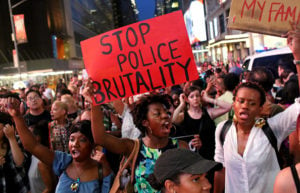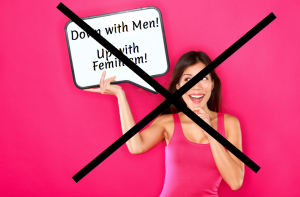This video is part of a series for Everyday Feminism, a website dedicated to helping you stand up to and break down everyday oppression.
The trailer for the recent Stonewall movie has been released, and people really seem to want to know what I think about it. If you don’t already know what Stonewall is, check out my last video [linked below] where I discuss in detail what Stonewall was and the environment that inspired the uprising that night.
Before we get into my criticisms of the trailer, I want to say that my desire is to be as honest as possible and not side with a certain narrative just because it’s consistent with my political stances.
Some of you are not going to like what I have to say.
After heavily studying Stonewall, I realized that there are some critical conversations we need to have about the era when Stonewall took place. People have called for a boycott of the film because of its lack of transgender and people of color representation.
Jeremy Irvine, the man who plays the fictional white protagonist in this film, responded to this criticism with the following:
Marsha P. Johnson is a major part of the movie, and although first hand accounts of who threw the first brick in the riots vary wildly, it is a fictional black transvestite character played by the very talented @vlad_alexis who pulls out the first brick in the riot scenes.
Now, a lot of people didn’t like this response, specifically his use of the term “transvestite.”
This is a term that in 2015 is cringe-worthy, but in 1969, it was a term that was in common use. As discussed in my previous video, Sylvia Rivera and Marsha P. Johnson started STAR, Street Transvestites Action Revolutionaries, a group focused on providing support to homeless trans women and drag queens.
Terms like “transgender” were absolutely around, but not in common use. Many of the people who we look at today and refer to as “trans women” were not seen that way in 1969 – and sometimes they didn’t identify themselves that way.
Let me be clear: Trans people existed and they were certainly a large part of Stonewall. However, the terminology and the way we view trans people has drastically shifted since 1969.
While it’s true that both Marsha and Sylvia went on to become strong activists in the trans community, on June 28th 1969, their gender identities and expressions were not nearly as binary as some people are painting them to be.
Part of me is a bit frustrated with the fact that people are demanding historical accuracy, but not wanting to be completely accurate when it comes to how both of these women defined themselves in 1969.
On the subject of terminology, what is also fascinating when you research this era is that, especially in Greenwich Villiage, the advocacy around Gay Liberation was very in-your-face. It was very common to take words that we would consider to be slurs in 2015 and wear them as a badge of honor.
Additionally, while I think it’s very important to tell the story of Stonewall because of the nation’s passing of marriage equality, it’s also important to understand that marriage wasn’t what they wanted in 1969. In fact, it was quite the opposite.
The Stonewall Riots, at its core, was about a bunch of people of various different backgrounds who were tired of not being able to be left alone without harassment. This was not a movement about assimilation into heteronormativity. It was about carving a space for themselves.
Ultimately, I believe it’s extremely important to not look at Stonewall through the scope of 2015.
There have been so many shifts in the way that we have these conversations that it’s important to always provide the proper context for the time period. Now initially, people were upset with Marsha and Sylvia not being in this film. Turns out, there is a character that plays Marsha, and one that plays a character that is supposed to be similar to Sylvia Rivera.
I can only assume that because some people debate Sylvia Rivera’s presence at Stonewall that they opted to go with a fictional character instead. That being said, Marsha is played by Otoja Abit and a character resembling Sylvia is played by Jonny Beauchamp.
There’s been a long-standing debate about cis actors playing trans characters. To me, this issue has many layers. If I’m being completely honest, I think that when it comes to the appearance of both Sylvia and Marsha in this film, I honestly think that the casting was pretty spot on.
But the question really is, what does casting cis actors in trans roles mean for trans actors? Well, casting cis actors in trans roles ultimately removes a layer of realism that could be presented to the film. It also communicates outside of the film that our gender is costume.
My issue is that trans actors are often not even considered for these roles. There are trans actors whose genders are not binary, and there are trans actors who are willing to de-transition for a role to play themselves pre-transition.
But trans actors are often not even auditioned – and essentially, that takes roles that were written for trans actors them away from them. Trans actors will tell you that the industry is hard enough. So essentially, casting cis people in trans roles perpetuates the struggles that trans actors go through.
Now, let’s move onto the subject of whitewashing. It’s really important to understand that Stonewall was essentially the place for the “undesireables” in the Village. If you couldn’t get into the other bars, this is where you went.
That meant that in comparison to the other bars in the area, there were certainly more trans people and more people of color. However, most of the patrons were indeed cis white men. But that’s not really the question. The question is: Is that what started the uproar that caused the riot?
Realistically, that is extremely unlikely.
In 1969, while yes anti-gay policies had become less harsh, it was still very common for the police to harass and sometimes beat you to an inch of your life if you were even perceived as gay.
This is also the time where if you were caught in a gay establishment, your name would be published in the paper. For some people, this could mean unemployment or excommunication from your community. The reality is that these were the times where if you could pass for straight, you did.
That’s one of the numerous reasons why when these bars were raided, that the patrons usually complied. But who was usually the target for these raids? Trans people and people of color.
Remember, this is 1969, segregation ended only five years earlier and there were laws that stated that you had to wear at least four articles of gender-appropriate clothing at all times.
Even if we overlook numerous first hand accounts, knowing what we know of the time, it’s extremely unlikely that cis white men started the uproar.
Trans people and people of color had more to lose. Remember, this was one of the few places where they could congregate in the Village. A lot of people are pointing to photos of the riots as a defense for the whitewashing of the movie.
What we need to understand is that people who weren’t at the Stonewall when the riots began came to the Stonewall Inn and the riot got larger and larger. So the people that you see in these photos aren’t really the most accurate depiction of who was actually in the bar.
The white washing of the story of Stonewall has been an issue for a while. When PBS did their Stonewall Uprising documentary, they only interviewed white attendees and overlooked trans women of color like Miss Major, who were there that evening and is still alive.
When I wrote a research paper about Stonewall in high school, I had no clue who Marsha, Sylvia, or Miss Major were. Hell, I didn’t even know that there were people of color were part of that community. The story, as it’s been told for years, has been overwhelmingly cis, overwhelmingly white, and overwhelmingly male.
And what did that communicate to me as a child? It communicated to me that we weren’t there and that we didn’t do anything – when in reality, trans people and people of color played a large role in the events that evening. We were a catalyst and we helped enact change for not only the trans community, but also for the gay community.
So while this movie does not claim to be a faithful retelling of the events that evening, for many people, it will be seen and taken that way. And young queer and questioning children of color will feel like they had no relevance in this historic event .
The erasure of women and their accomplishments in civil rights movements is, unfortunately, very common. And to me, this was a missed opportunity where a story could have been told from the perspective of Marsha, or Sylvia, Major, or even Storme, but instead they opted to tell the story from the perspective of a cis white male and place him in the role of a hero.
To me, the conscious decision to create a fictional white narrative is what we should criticize about this film overall. As Miss Major said, “Just because there’s this umbrella, LGBT, we’re all grouped together.
But guess what. Someone poked a hole in the umbrella, and the girls are still getting wet.”
The women of color that were at Stonewall that evening made great contributions to society and should not be forgotten. Of the four that I’ve mentioned, Miss Major is still alive and still advocating for trans women. Right now there’s a film being made about her called Major that is in need of funding.
There’s also a film about Marsha P. Johnson’s birthday celebration that evening at The Stonewall Inn called Happy Birthday Marsha that is also in need of funding.
While I think criticism of this film’s trailer is warranted, we haven’t seen the film in its entirety. But what we do know is that the film sidelines these women.
I think if we want better films about our stories to be made, we need to start empowering the people who are already trying to make them and hope that Hollywood will see through these projects that our stories are worthy of the silver screen and should be told.
Kat Blaque of Everyday Feminism, signing out.




















